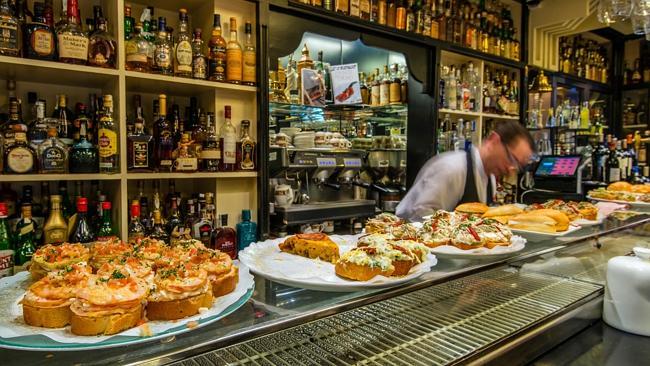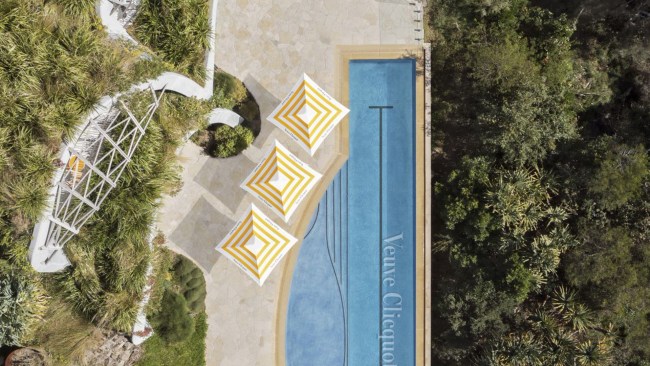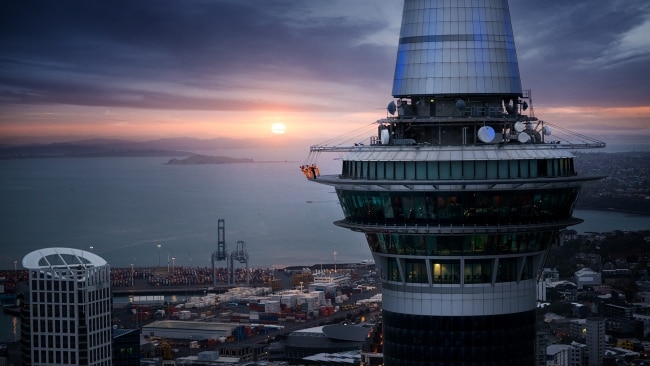Basque Country: dining well on the pilgrims’ Camino trail
The Basque Country is littered with world-class chefs, fine food and great wine.

“Pedro Subijana, Juan Mari Arzak, Martin Berasategui, Eneko Atxa, Andoni Luis Aduriz ...” Our guide, David Elexgaray, effortlessly reels off the names of world-class Basque chefs.
“Don’t ask me to try listing film stars or footballers. But food? That’s what we Basques really care about.”
On an evening walk around Bilbao, capital of Spain’s food-oriented Basque region, it’s perhaps right that our feet should turn out to be in the service of our stomachs. David prefers the local term txikiteo to describe our companionable stroll (a bar crawl in less civilised cultures) between refreshment stops.
We graze our way through the spill of students and office workers along buzzy Calle Licenciado Poza, downing canas (small measures) of beer or of txakoli, the region’s mildly bubbly white wine, along with the distinctive cocktail-stick tapas that the Basques know as pintxos (skewers). There are gilda (anchovies, olive and hot peppers), pintxos morunos (Moorish kebabs), rabas (fried squid) and croquetas de rabo de toro (potato dumplings with bull’s tail).
This bite-sized outing proves a fitting introduction to our guided tour of northern Spain; it’s our fortnight in miniature, which will see us eat and drink our way across the Basque Country and Navarre, Asturias and Galicia, but also find time for plenty of walking.
The region may hold an exceptional culinary hand — Rioja wines, superb local meats, cheeses and seafood, and a greater density of Michelin stars than anywhere else on Earth — but that’s not its only draw. The bronze scallop shell symbols set in the pavement at our feet remind us we’re slap-bang on the Camino, Europe’s premier pilgrimage route to the holy city of Santiago de Compostela.
The well-trodden Camino is actually a series of tributary paths — such as Via Regia, Camino Frances and the coastal Primitivo — that originate in Paris, Italy and elsewhere before converging on the great shrine of St James, Spain’s patron saint, at Santiago in Galicia.
Most pilgrims take at least a month on the trail, resting and refuelling at budget hostels along the way. But we are plain cheating, with classy lodgings, limiting ourselves to the Camino’s standout sections, and otherwise getting about by minibus, largely because we’ve rather more serious eating and drinking to fit in than your average pilgrim. Continuing this very evening, as David reminds us, with a date at one of the Basque Country’s most cherished institutions, the txoko (gastronomic club), where amateur chefs cook for friends and guests in discreet, even off-grid locations.
Some of us think not so much Michelin as mugging when David leads us to an unprepossessing apartment building on a poorly lit Bilbao backstreet. Our faith is back in a rush when we’re shown into Txoko Bilanda, an open-plan interior that’s a welcomingly stylish if perhaps eccentric combo of kitchen, gentlemen’s club (wall-mounted antlers) and games room (table football and darts), with pride of place reserved for the communal dining table. We feast on blood meatballs with pistachio, cod in pil-pil sauce, a stew of hake and octopus and a fine piece of rare beef.
By morning, we’ve come to appreciate that while our time on the Camino may not save our souls, it sure will have a part to play in widening our waistlines.
We’re back in walking boots that afternoon, rejoining the path at the village of Uterga in Navarre, where we pass fields of white asparagus, a regional specialty, wild meadows thick with vetch and orchids, and villages dominated by vast pelota (Basque racquet) courts. We stop to admire the scallop shells, by tradition the pilgrim’s makeshift plate-cum-cup, carved in the exquisite portal at the 12th-century Hermitage of Santa Maria de Eunate. Old brick factory chimneys topped with storks’ nests line the approach to the Roman bridge at Puente la Reina.
By the time we reach Logrono we’re even rediscovering our appetites, and the provincial capital of the Rioja region proves just the place. Deep in the picturesque old town, on Calle Laurel and the surrounding alleys, we find a fabulous tapas scene, each bar with its specialist offering — the no-frills Bar Soriano (a skewer of garlic mushrooms topped by a prawn); La Taberna del Laurel (pork loin with foie gras); and Juan Y Pinchame (an excellent if unorthodox prawn and salted pineapple kebab).
Before bed, I wander past Logrono’s great Cathedral de Santiago Real with its baroque-era statue of St James on horseback, the mythical Moor-slayer’s rearing steed fetlock-deep in decapitated Muslims. After an evening of such wonderful food, clearly lifted from Moorish and Middle Eastern mezze cuisines, I’m minded to observe that St James might have been more forgiving.
At Santo Domingo de Calzada’s 12th-century cathedral there’s less of the sectarian slaughter but plenty of Catholicism at its most endearingly kooky, in the form of a highly revered chicken coop. The cathedral’s resident hen and rooster, their presence sanctioned by ancient papal decree, commemorate a miracle in which two roast chooks destined for the dinner table were wondrously restored to life. For centuries, pilgrims coveted the birds’ feathers as talismans to keep them safe on their journeys.
But we’re done with the Camino for the day and will be spending a less arduous afternoon acquainting ourselves with another miracle of Rioja: the wonderful wines of a region perfectly positioned between the withering heat of the Castilian meseta (plain) to the south and the damp littoral to the north. The classic whites (sauvignon blanc and verdejo) we taste at the Marques de Riscal winery certainly linger but what truly distinguishes the tour is the City of Wine, the landmark hotel-restaurant building of Frank Gehry. The architect responsible for Bilbao’s Guggenheim Museum has conjured a radical titanium vision amid the vineyards, this time in pink, silver and gold, the winery’s signature colours.
In the mountain village of Ezcaray, we overnight at Echaurren, for five generations a renowned eatery and now a famed (and impressively chic) hotel gastronomico offering an award-winning range of restaurants, bars and bistros. Dinner is excellent, but it’s the breakfast I cherish for such singular delights as cuajada (a thick local cream with honey and walnuts), cabeza de jabali con pistachos (a salami of wild boar head with pistachio), and an intense garlicky rallado (a tomato pulp on toast).
This same breakfast sets us up for the morning’s three-hour hike on a popular detour from the main Camino. The minibus leaves us at the village of Pazuengos where we climb past pastures and beech woods to a panoramic ridge below the snow-capped peaks of the Sierra de Cameros. We descend to the village of San Millan de la Cogolla and rest in the shadow of the Monasterio de Suso, a UNESCO World Heritage site that’s home to some of the earliest texts written in Spanish.
In the afternoon we reach Burgos, ancient capital of Castile, where the Camino runs right through the centre. Burgos is home to Boteria Domingo, one of the last traditional makers of leather wine flasks. At this fourth-generation family business, Jorge and Rocio demonstrate how to make the time-honoured item of Camino kit, cutting and stitching the goat hide before sealing the bag with pitch. We make time for the city’s soaring 13th-century cathedral, the resting place of Spain’s warrior liberator, El Cid, and a masterpiece of gothic devotional architecture.
The cathedral is trumped the following day, however, by the one at Leon, the so-called House of Light. Here the medieval stained-glass windows, which extend to about 1800sq m, many now restored to their former glory, move us almost to tears. We revive at La Rinconada, a humble tapas bar in Leon’s barrio humido (or “wet quarter’’, on account of the drinking done there), with no-nonsense tapas plates of morcilla (blood sausage) and rinones (kidneys) washed down with shots of heavy Rioja.
Beyond Leon’s meseta we plunge into the green mountains of Asturias. Dinner that evening, one of the trip’s culinary highlights, is at the two-Michelin-star Casa Marcial. Multiple courses, which include inspired remakes of traditional dishes such as fabada (bean stew) and young goat, reference the restaurant’s hillside setting amid abundant pastures and traditional Asturian granaries. But the meal is also rich in reminders of the nearby Atlantic, where we’ll soon be covering stretches of the Camino Primitivo, by way of plates of limpets and seaweeds, mullet served in a salt shell, and even bone-dry slabs of bacalhau (salt cod).
With an accompaniment of ciders, sherries and wines, including a memorable Marques de Riscal 1994, it’s no surprise that we’re not done until after midnight. On the way back to the hotel somebody murmurs, “Do we ever get to Santiago?’’ That remains to be seen, but with distractions like these, we’re in no hurry to find out.
Jeremy Seal was a guest of Utracks.
Checklist
Utracks conducts a 15-day Food Lover’s Spanish Camino tour, with next departures on May 20 and September 9, 2017, from Bilbao to Santiago. The cost is $6190 a person twin-share, including most meals, hotels, guided visits and wine tastings; the tour is escorted by a bilingual leader and joined at points by local gastronomic experts.
More: utracks.com.


